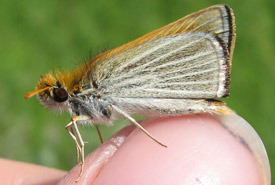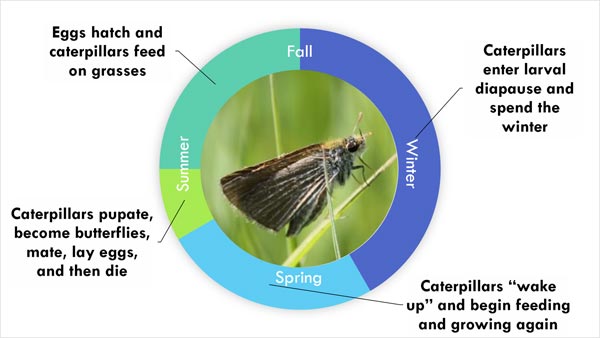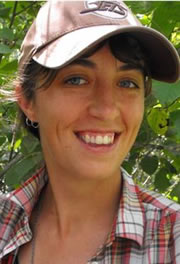Poweshiek winter wonderland

Poweshiek skipperling (Photo by Jaimee Dupont/NCC staff)
Forget about crocuses and birds — the first sure sign of spring on the prairies is when the insects start to fly around. Have you ever wondered what happens to the insects in the winter? A few, like the monarch, fly south with the birds, but the majority of Canada’s insects have to make do with our winters.
Most enter a period of dormancy called diapause and are inactive throughout the cold months. Each type of insect has a preferred winter habitat, such as in the soil or sheltered by vegetation, and each has a range of tolerance for harsh winter conditions.
Understanding an insect’s winter ecology is a crucial part of understanding what it needs to survive, and this is even more important when that insect is an endangered species.

Lifecycle of a Poweshiek skipperling (Graphic by NCC)
Rarer than giant pandas, Poweshiek skipperlings are small butterflies that live in the tall grass prairie. They live for one year, mainly as larvae (caterpillars), and fly as adult butterflies for a few weeks in July at Manitoba’s Tall Grass Prairie Preserve. The larvae are the life form that pass the winter in Manitoba, and as part of NCC’s efforts to recover this endangered species, we are embarking on research to better understand their winter habitats.
To the best of our knowledge, Poweshiek skipperlings spend the winter close to the ground, sheltered from extreme cold and dry air by an insulating layer of snow. This information leads us to ask additional questions: Do we see more Poweshieks in the summer after a winter with a lot of snow? Do we see less when it’s been particularly cold? Or what about when it warms up above 0 C for a week in February and the snowpack declines?
NCC’s Manitoba team has begun to monitor winter weather conditions at the sites where they are found. This will help to answer our questions, and to gain a better idea of what winter conditions are like for Poweshieks. We set up cameras to measure snow depth throughout the winter and digital weather loggers to record temperature and humidity. This will help us avoid wandering around where the tiny caterpillars might be spending the winter. We’ll then put the photos together with the data to get a better understanding of the winter conditions for Poweshiek skipperlings in Manitoba.
NCC’s efforts to recover the Poweshiek skipperling are part of an ongoing multi-faceted program that we are conducting together with many partners in Canada and the United States. Multi-year monitoring means we will be able to identify the effects of different winter conditions on Poweshiek populations. This can help us identify the species’ natural population shifts in winter weather and to understand the potential effects of climate change.
Understanding winter weather conditions may also help our partners at the Assiniboine Park and Minnesota zoos. The zoos' are developing captive rearing programs to hopefully bolster wild Poweshiek numbers in the future. The zoos overwinter the larvae in controlled conditions. Knowledge of the species' tolerance and preference for winter conditions can help improve Poweshiek survival through their winter dormancy.
Overall, this winter monitoring is a small but important piece in the Poweshiek skipperling research puzzle.


